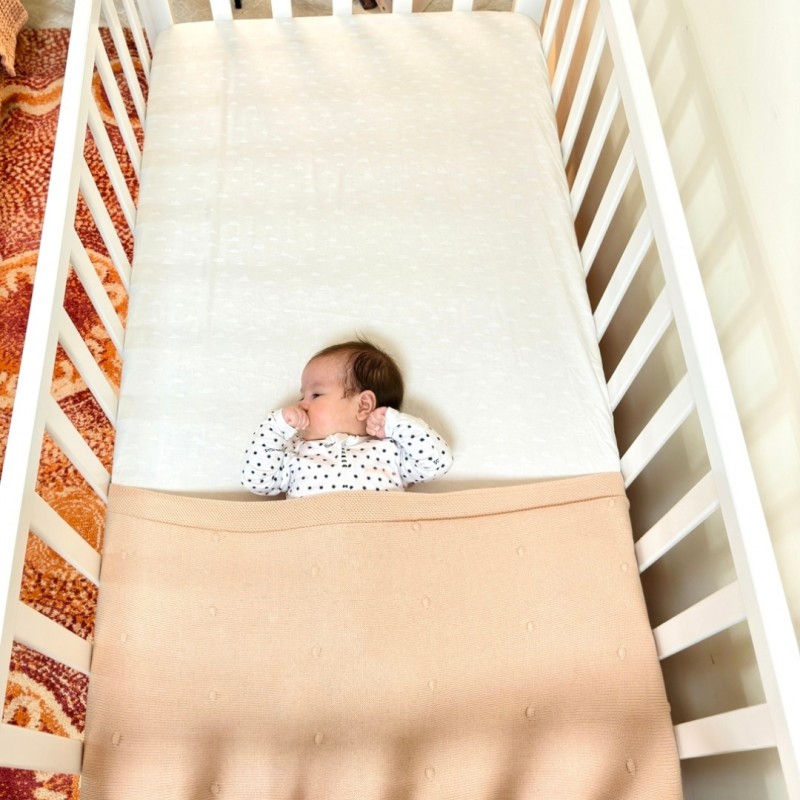Soft toys and comforters for babies are popular products. They come in different shapes and sizes and are usually cute stuffed animals. Some have a fabric skirt that looks like a mini blanket. Parents and carers often ask Red Nose educators whether these products are safe to use and should they use one to sooth their baby.

When answering questions about soft toys and comforters, Red Nose refers to its research-based six Safe Sleep Recommendations and the Triple Risk model which explains the factors that increase the risks of sudden unexpected death in infancy (SUDI) and sudden infant death syndrome (SIDS) to provide guidance.
One of our Safe Sleep recommendations is to keep baby’s face and head uncovered. Babies control their temperature through their face and head, so keeping baby’s face and head uncovered during sleep helps reduce the risk of overheating. It also helps keep their airways (breathing tube) clear, reducing the risk of suffocation. Therefore, it’s important to keep a baby’s sleep space clear of any items that could potentially cover their face and head.
Should soft toys and comforters be used?
For babies from birth up to 7 months old - corrected for prematurity: Red Nose strongly recommends that parents and carers do not use soft toys or comforters for this age-group as it is the critical developmental period, which is the time a baby is at greatest risk of SUDI occurring. Research shows that around 90% of SUDI cases occur during this stage. The risk of suffocation and strangulation from soft toys or comforters outweighs any benefit.
For infants 7 months and older: Once a baby passes the critical developmental period, the risk of SUDI and SIDS decreases. Older infants and toddlers may find comfort in a soft toy to ease separation anxiety, a normal developmental stage occurring between 7-20 months of age.
However, Red Nose recommends nothing in the sleep space with baby for the first 12 months and encourages parents and carers to weigh up the risks and benefits of providing a small soft toy to support infant settling.
If choosing a comfort item for an older infant, ensure it meets Australian Safety Standards, is small in size, not pillow-like, and does not have a blanket or long fabric attachments (e.g. unstuffed ears, legs) that a baby can fold into its mouth. Visit the ACCC Your First Steps and Product Australia for guidance on product safety.
If you use a soft toy or comforter, monitor your baby or child closely to see how they interact with the item in their sleep space. Remove the soft toy or comforter if your baby or child:
- covers their face or head with it,
- is unable to move it away from their face or head,
- rests their head on it like a pillow creating a chin on chest position and reducing air intake
- uses the comforter to lift themselves up in the cot and risks falling out, or
- puts the toy into their mouth, potentially blocking their airway or becomes a choking hazard.
Your Maternal Child Health Nurse can advise alternative soothing methods to assist your child with separation anxiety if a soft toy or comforter is not suitable.
If your baby is in formal childcare, be aware that early childhood education and care settings are regulated by a National Quality Framework and sleep and rest legislative requirements. The Australian Children’s Care and Education Quality Authority (ACECQA) sleep and rest policy and procedure guidelines state when deciding whether soft toys and comforters can be used in the sleep space Early Childhood Educators should refer to:
- best practice guidance by recognised authorities, such as Red Nose Australia; and
- the service’s sleep and rest policy and procedure, including sleep and rest risk assessments.
Educators need to consider how they can work in partnership with families to achieve positive outcomes for children without compromising the child’s safety.
When working in partnership with families, if a decision is made to offer a small soft toy or comforter to an older infant (over 7 months of age, corrected for prematurity), Red Nose best practice guidance recommends conducting an individual risk assessment and providing continuous supervision with bedside physical checks during sleep and rest, in alignment with the early childhood education and care service’s sleep and rest policy and procedures.
The key things to remember regarding soft toys and comforters are:
- Keep soft toys out of the sleeping environment for babies during the critical developmental period (birth up to 7 months of age - corrected for prematurity) and ideally for the first 12 months.
- For older infants (over 7months of age - corrected for prematurity) experiencing separation anxiety, parents and caregivers should weigh the risks and benefits of providing a small soft toy as a transitional object to support infant settling.
- If you choose to use a comfort item to assist your older infant in settling, it is important to still follow Red Nose Safe Sleep Recommendations, including placing your baby to sleep on their back on a firm, flat surface, and ensuring their head and face remain uncovered at all times.
- Monitoring how your baby or child interacts with a comfort item in the sleep space is important for assessing whether it is safe.
If you are uncertain about your child’s development and abilities to manage a small comforter, you should speak to your Maternal Child Health Nurse/Child and Family Health Nurse or doctor. Remember that each infant is unique. Always consult healthcare professionals for individual advice.
If you need more Safe Sleep advice, you can ask our Red Nose Educators questions through our website or by calling our Safe Sleep Advice line 1300 998 698 9am to 5pm (AEST) Monday to Friday.
We also have downloadable education brochures available here.
Last modified: 3/12/24
